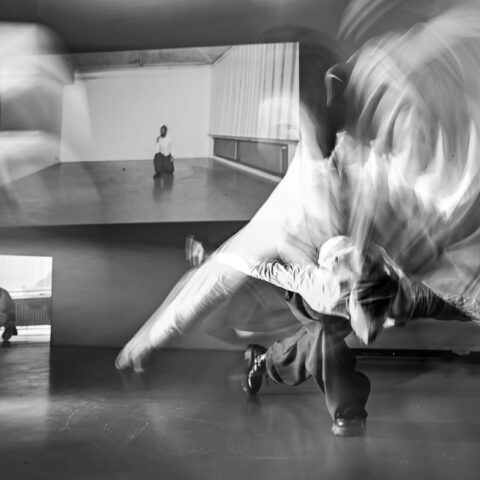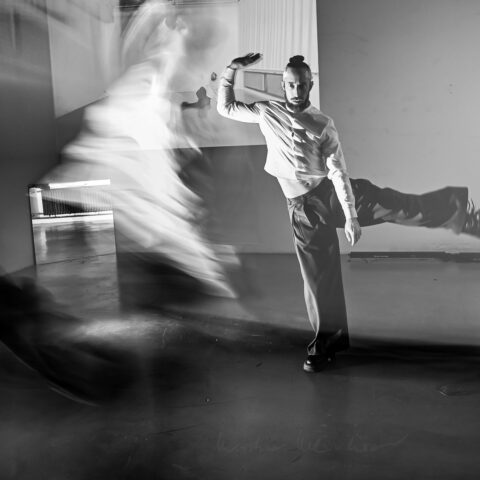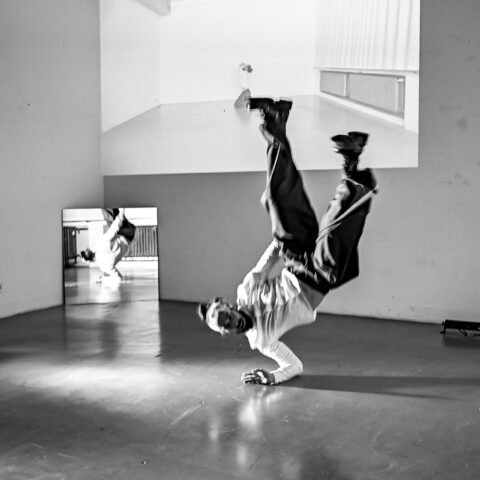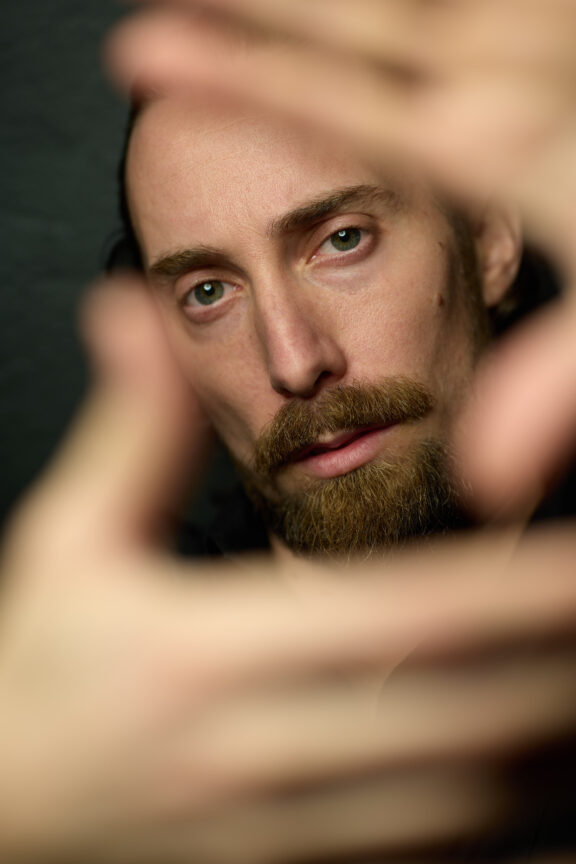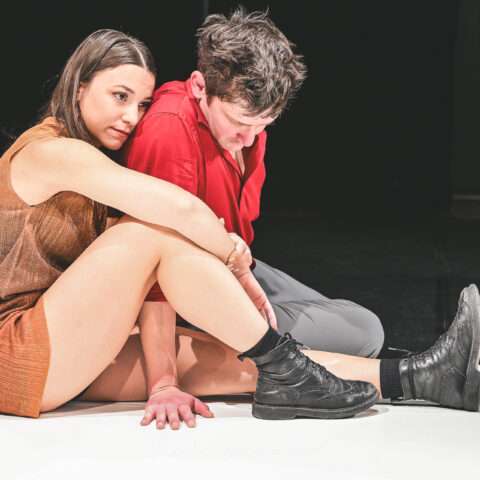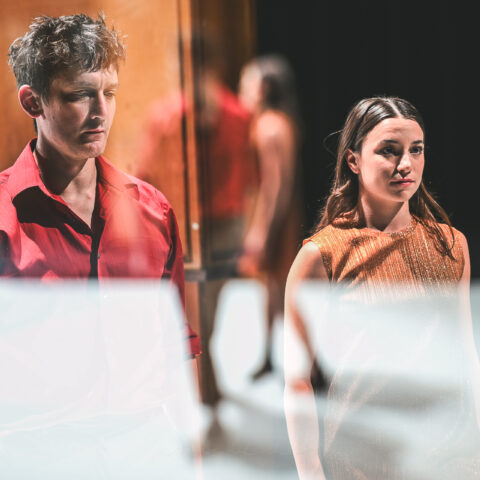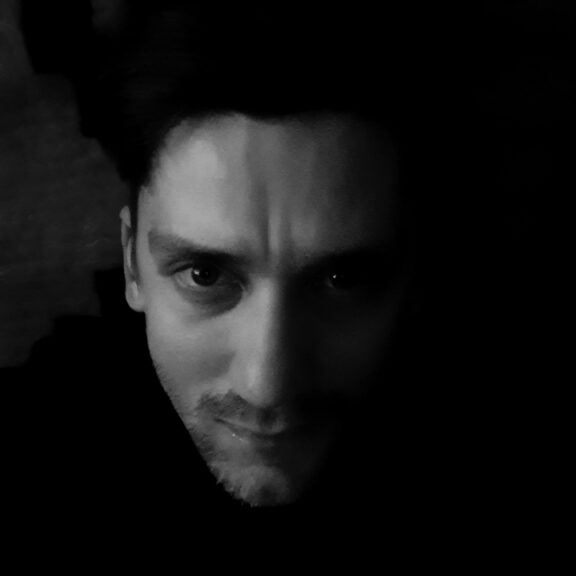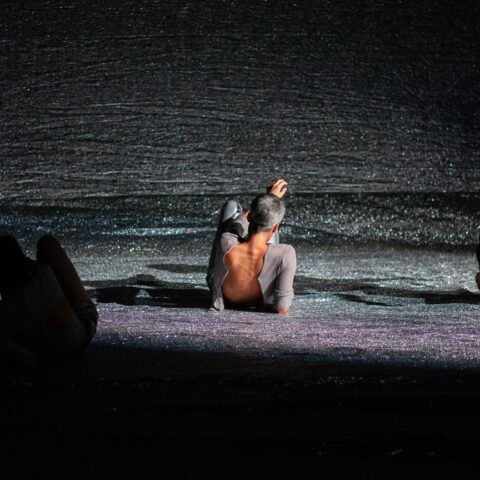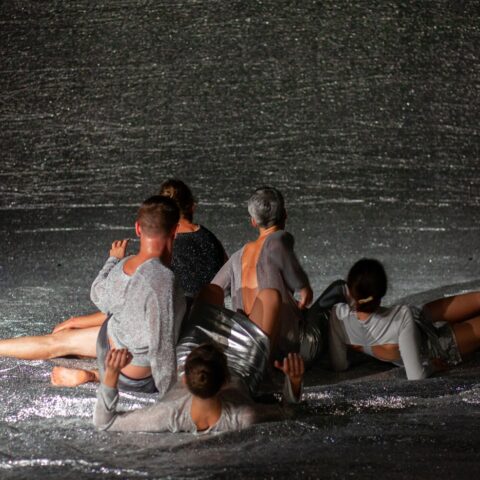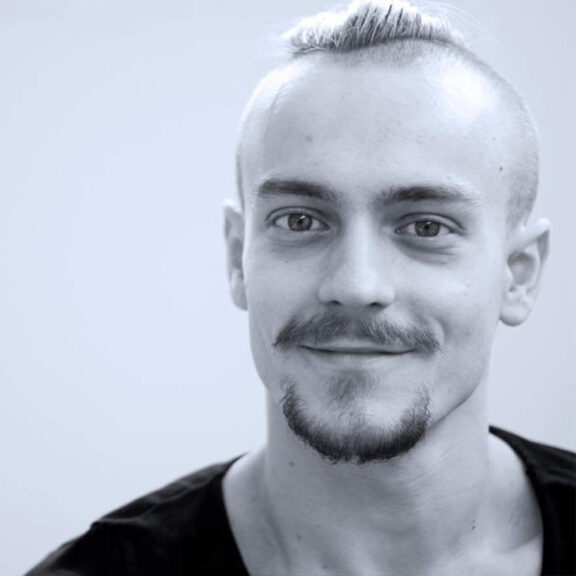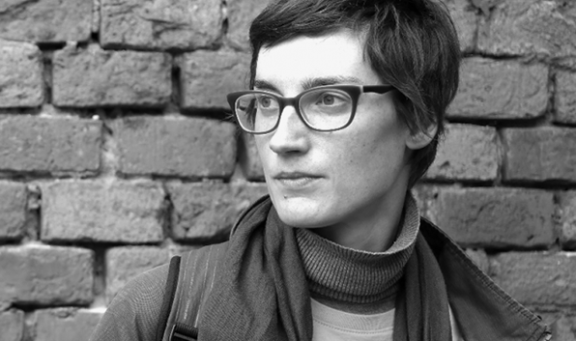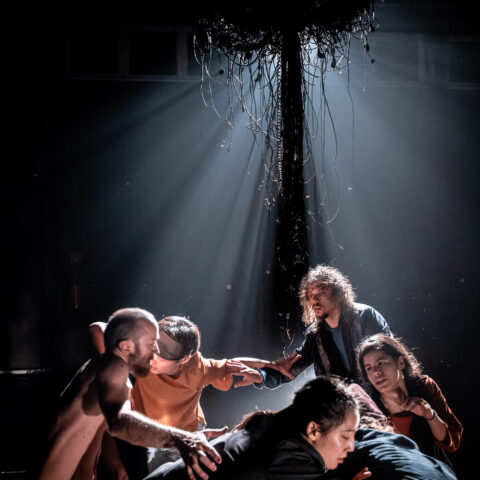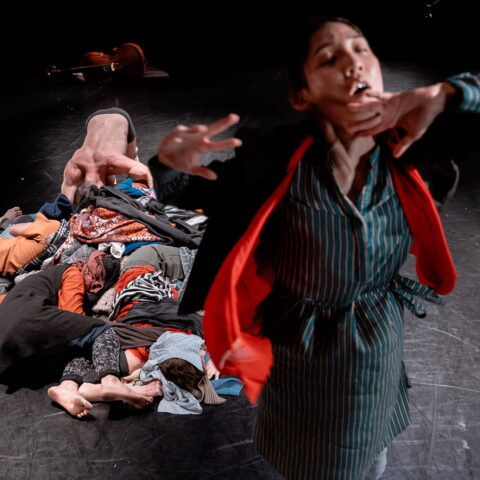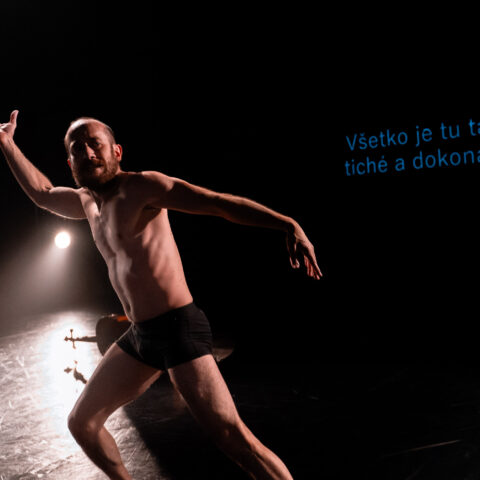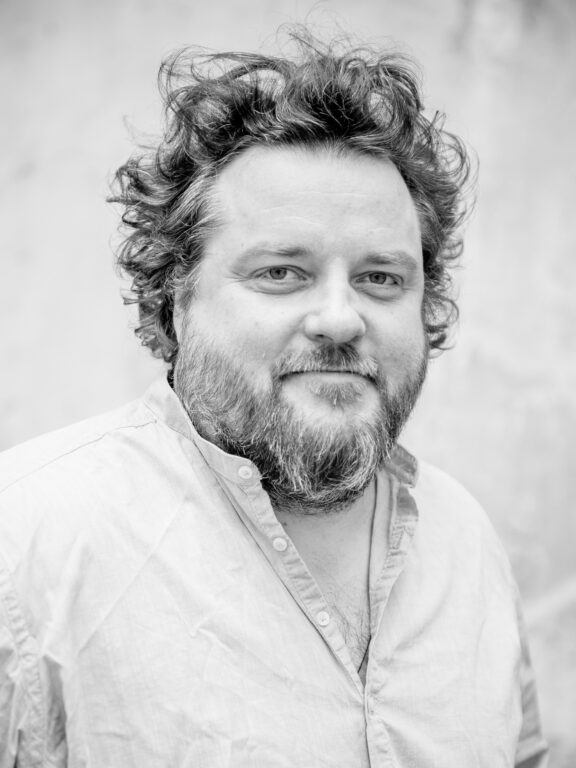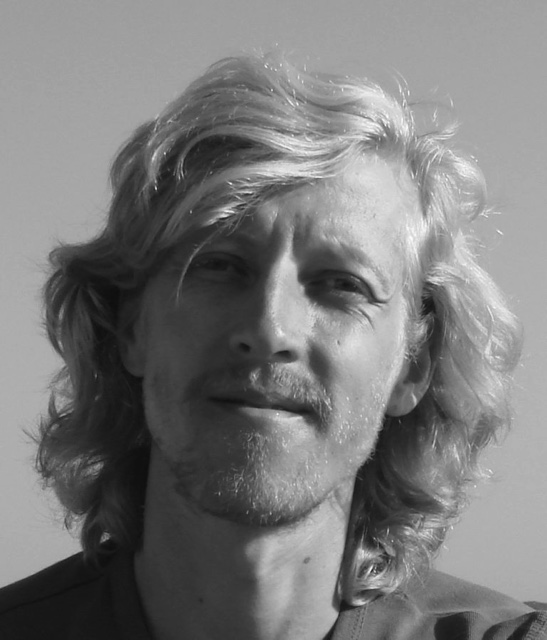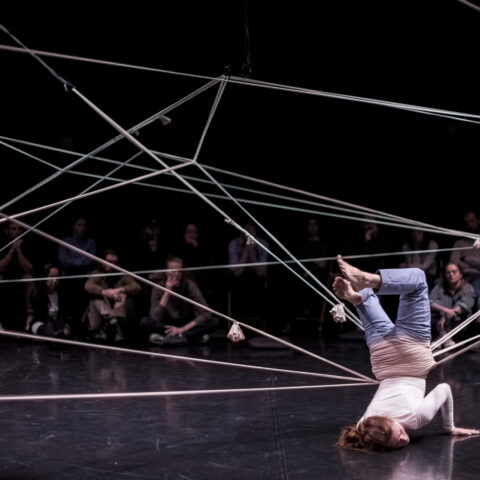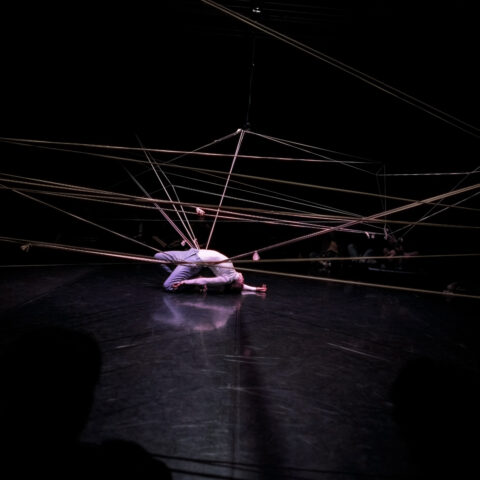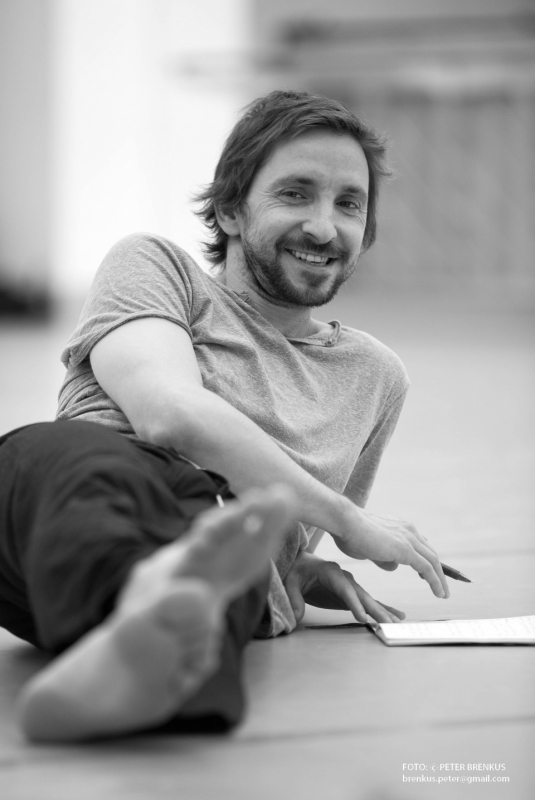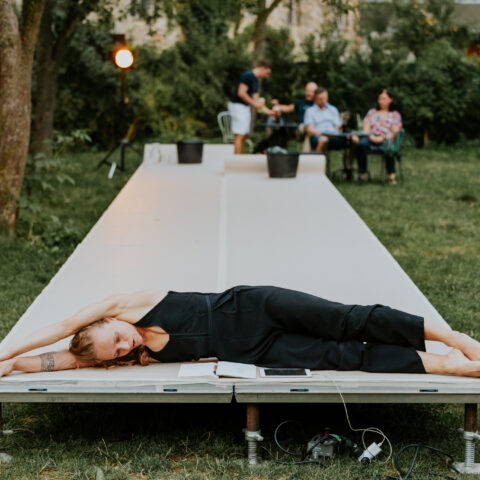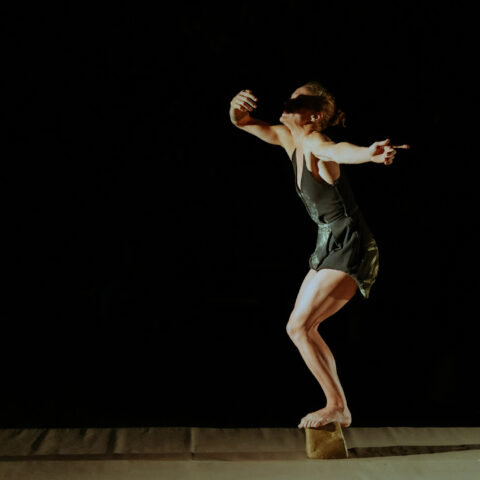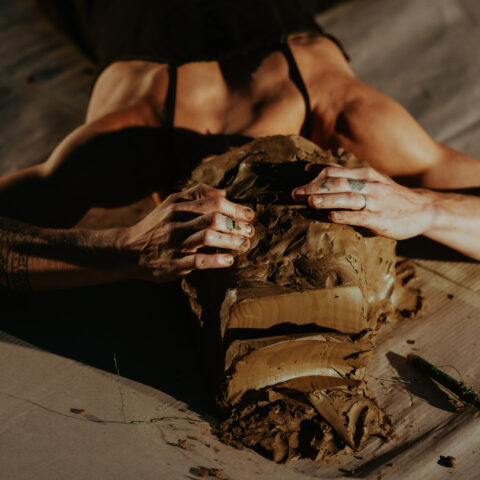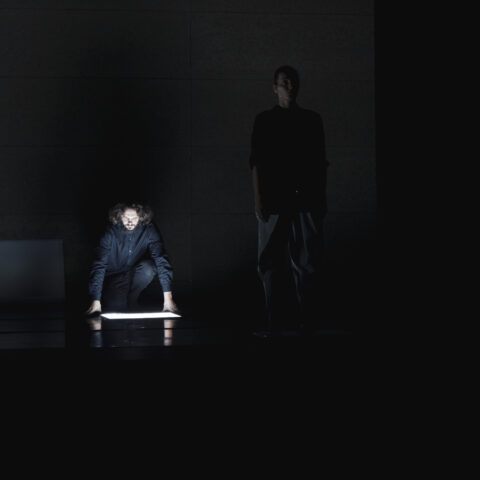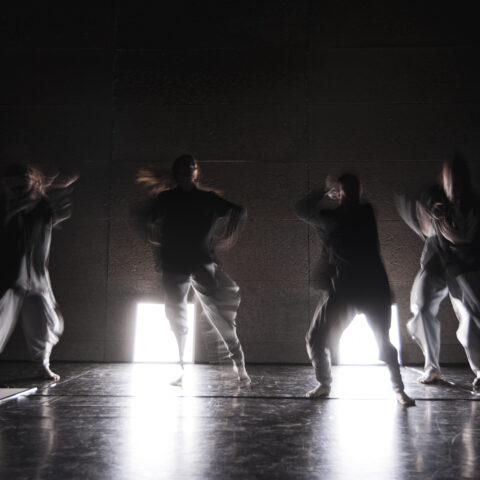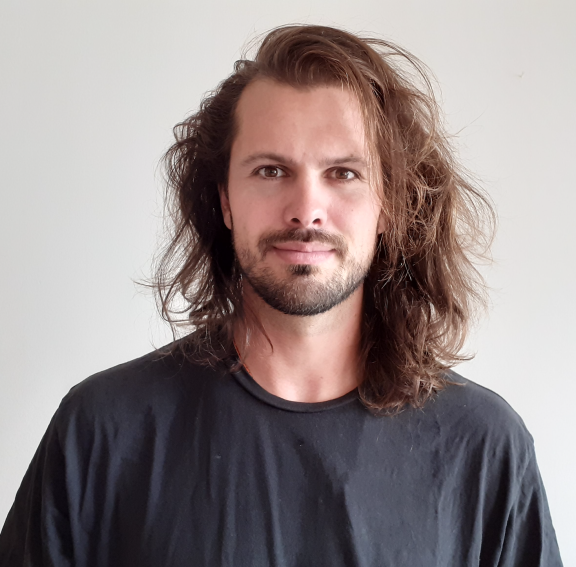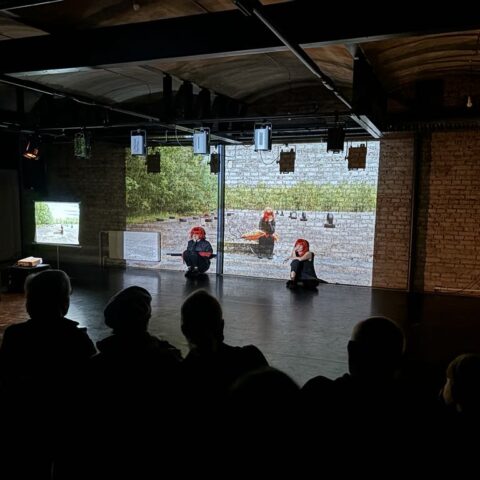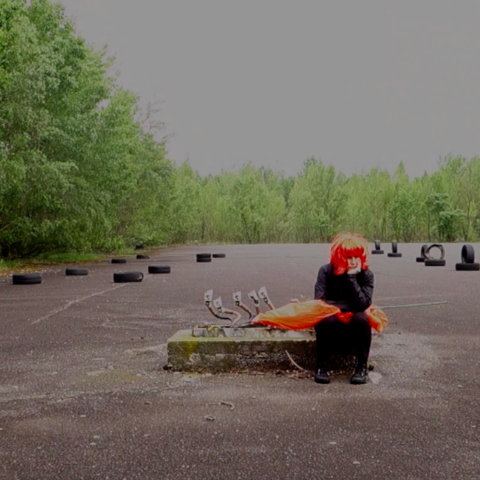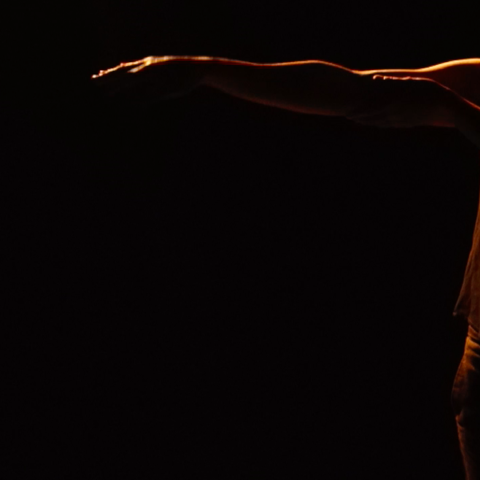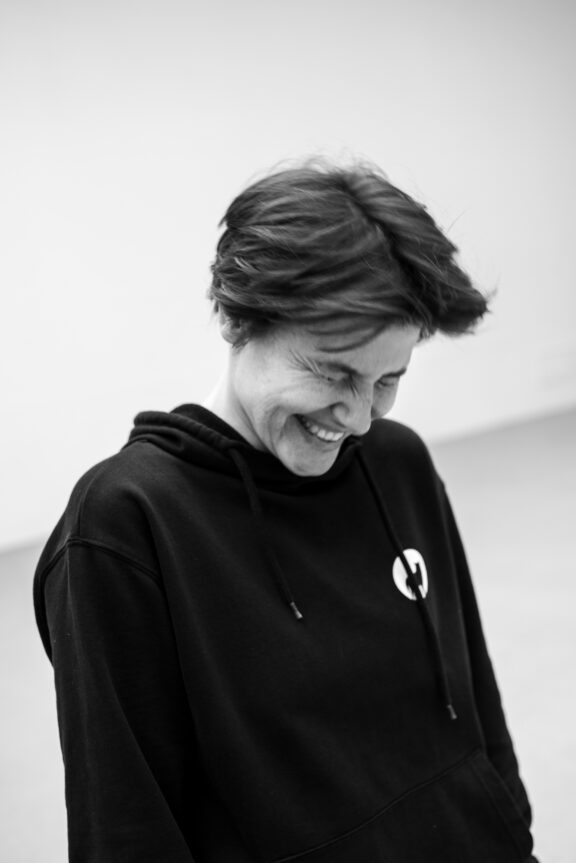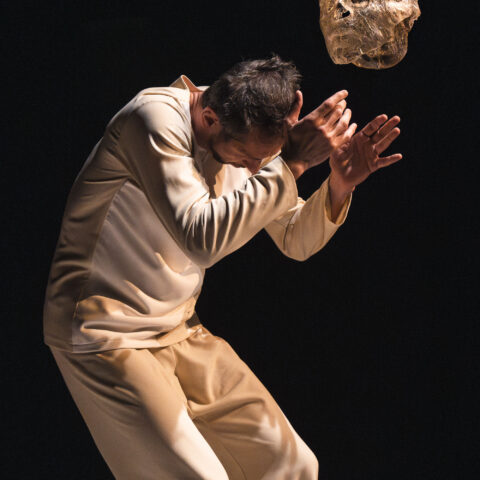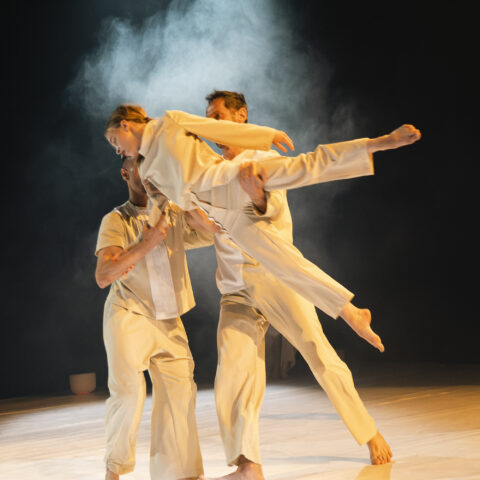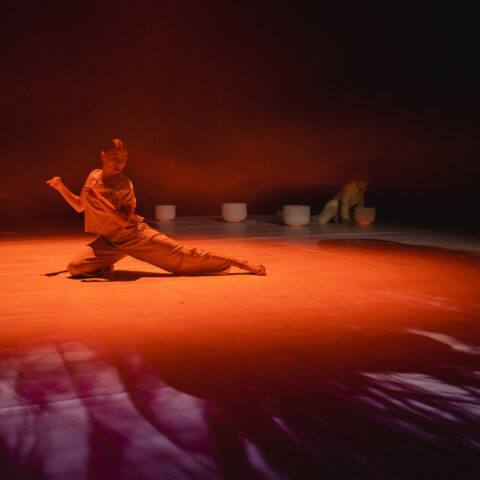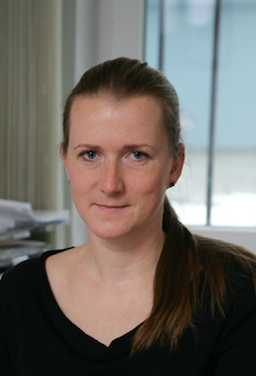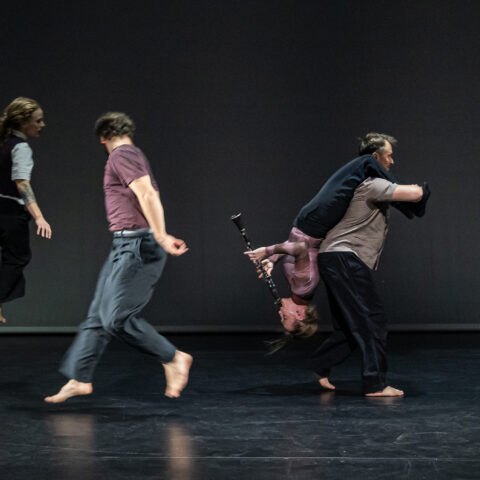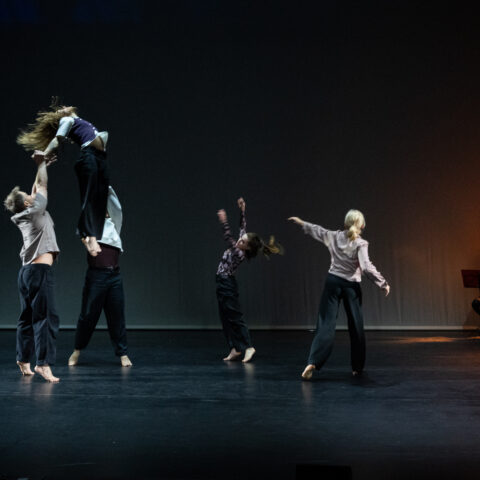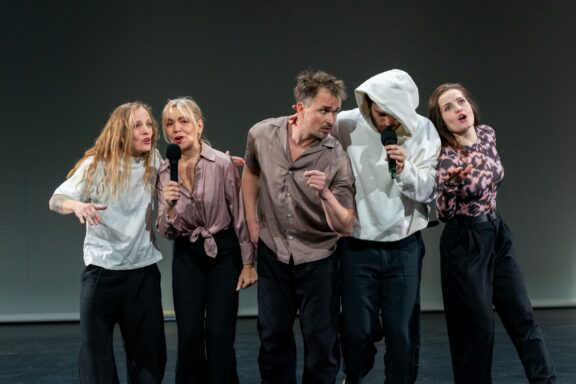In his introspective solo I Am Placebo, Michal Heriban explores the relativity of the present moment. He questions how memory, the subconscious, and habits influence our actions, our perception of ourselves, and the world around us. The intriguingly layered stage design—featuring a projection screen, a mirror, and shirts hanging on the wall—creates an impression of a multidimensional reality, a space where we can glimpse the past, be alone with ourselves, and dare to reveal our true selves—whether genuinely or only seemingly. In this dynamic and physically demanding choreography, precise and structured movements alternate with improvisation, mirroring life itself—if we can organize and reassess the past, we have a foundation to rely on when facing unexpected challenges in the present.
Mira Kovářová
A dance-visual performance with choreography by Michal Heriban and original, evocative music by Jozef Vlk explores the themes of human memory, automated behavior stored in the subconscious, unconscious habits, and conscious programming. Thorugh three episodes and three movement approaches, the audience observes how body memory, structured choreography, and improvisation behave in a mutual flow.
Concept by: Michal Heriban
Choreography: Michal Heriban
Performers: Michal Heriban
Lighting design: Veronika Malgot, Kristýna Hauptová
Music: Jozef Vlk
Sound design: Ondrej Geče
Costumes: Andrea Pojezdálová, Michal Heriban
Production: Michal Heriban, Veronika Malgot, One Breath Theatre
Promotion, PR: Michal Heriban
Like in Tarkovsky’s movies, this duet opens spaces between people, revealing all that normally goes unnoticed – not just between two individuals. Revisiting the traditionalism of a male-female duet, it transcends form, reaching into the essence of togetherness and coexistence, while not avoiding the ever- present void of loneliness. Melancholic as it may seem, it carries a strangely pragmatic and understated simplicity. It is a dance piece, yet one that could be defined as purified existence rather than anything else. Accompanied by Sehr Langsam from Mahler’s 5th symphony, masterfully manipulated by Tomer Avraham, the music resonates deeply while steering clear of clichés.
Choreography and interpretation: Tomas Danielis
Music: Gustav Mahler, Tomer Avraham
Graphics: Matej Lacko
Production: JISDF, FEYNmen,
Partners: Slovak Institute in Jerusalem, Studio 12
In his introspective solo I Am Placebo, Michal Heriban explores the relativity of the present moment. He questions how memory, the subconscious, and habits influence our actions, our perception of ourselves, and the world around us. The intriguingly layered stage design—featuring a projection screen, a mirror, and shirts hanging on the wall—creates an impression of a multidimensional reality, a space where we can glimpse the past, be alone with ourselves, and dare to reveal our true selves—whether genuinely or only seemingly. In this dynamic and physically demanding choreography, precise and structured movements alternate with improvisation, mirroring life itself—if we can organize and reassess the past, we have a foundation to rely on when facing unexpected challenges in the present.
Mira Kovářová
A dance-visual performance with choreography by Michal Heriban and original, evocative music by Jozef Vlk explores the themes of human memory, automated behavior stored in the subconscious, unconscious habits, and conscious programming. Thorugh three episodes and three movement approaches, the audience observes how body memory, structured choreography, and improvisation behave in a mutual flow.
Concept by: Michal Heriban
Choreography: Michal Heriban
Performers: Michal Heriban
Lighting design: Veronika Malgot, Kristýna Hauptová
Music: Jozef Vlk
Sound design: Ondrej Geče
Costumes: Andrea Pojezdálová, Michal Heriban
Production: Michal Heriban, Veronika Malgot, One Breath Theatre
Promotion, PR: Michal Heriban
The project Story appears as a rather extensive, Beatnik-style, cybernetic composition evoking a dystopian setting. It presents a visually compelling image, conceptual work with variations, gestures, and interactions between performers, excellent aleatory work with the tempo-rhythm of the performance, and an uncompromising artistic stance on both content and form. The body as a visual object as well as a conceptual intent: a fantastic, minimalist “gig” with a remarkable ability to communicate with the audience.
Jozef Vlk
Inspired by sci-fi poetics, choreographer Juraj Korec creates a playing field on the edge of the event horizon, of a crumbling world order and the dilemma surrounding the use of AI. Within this space, five mysterious identities—singularities—abandon the previously known and, bound by an inexorable algorithm, succumb to the call of gravity. Their stories emerge in hints, seemingly significant yet ephemeral, interchangeable with countless others. The micro-stories inscribed into our bodies each day remain yet are simultaneously lost forever, like imprints of bodies in the dust of lunar eternity. Where can one go if one can only go backward? The international co-production dance project The STORY offers a reflection on the way stories can be told through the body, employing a radical strategy that allows viewers a truly voyeuristic observation of bodily identities. The perspectives of performer and spectator never meet. In the moments of birth and disappearance of bodily identities, the motivations for their actions are revealed. This project is part of Juraj Korec’s broader and long-term exploration of the performativity of the body within contemporary dance and visual media, following the interdisciplinary research project, Expose Yourself to a Body.
Concept and choreography: Juraj Korec
Choreography and performance: Alexandra Mireková, Eli Hooker/Lukáš Bobalik, Eva Priečková, Jakob Jautz, Silvia Sviteková
Dramaturgy: Maja Hriešik
Scenography: Jakub Kopec
Sound design: Matúš Bolka
Light design: Felix Noslier, Juraj Korec
Graphic design: Kristína Šebejová
Production: Martin Krištof, Skrzprst
Co-production: CieLAROQUE / helene weinzierl
Lukáš Bobalik is a prominent figure among the younger generation of dance artists in Slovakia. His work systematically explores human existence, the boundaries of being, and the manipulation of energy and its sources. In Light Work, alongside dramaturge Maja Hriešik and visual artist Dana Tomečková, he focuses on physical performance and its fluidity. On a physical level, Bobalik delicately develops the theme of exertion, seeking ways to achieve and maintain a fragile balance of human energy. Performer Tomečková naturally contrasts this by incorporating seemingly unstable objects—tubular structures—into the composition. Together, they engage in a shared dialogue exploring the process of balance in various forms.
Stanislava Vlk Vlčeková
A solo in which there are two of them at the same time. Each person is striving for something for himself, looking for his own methods. It prolongs the moment of lightness, delays the fall. Occasionally he presses the saw, can’t help trying. A delicate balance in dialogue with the other, with material and physical forces. The oscillation of the drive to build, to grow, to move forward and the gravity that pushes clearly – down. Can we let go of our own efforts? And what happens if we no longer hold anything on?
Concept by: Lukáš Bobalik, Maja Hriešik, Dana Tomečková
Choreography, dance: Lukáš Bobalik
Dramaturgy: Maja Hriešik
Art collaboration: Dana Tomečková
Movement cooperation: Jaro Viňarský
Music: Nikolaj Nikitin
Costume: Michaela Bednárová/puojd
Lighting design: Lukáš Kubičina
Visual, graphic design: Alena Koleso
Production, touring: Alexandra Mireková
The distinct creative duo—director and composer Andrej Kalinka and choreographer Milan Kozánek from the Med a Prach collective—collaborated with the Dance Studio Theater to create a compelling work: a polyphonic music-movement stage composition reflecting a state of global amnesia. Their specific theatrical language, moving at the boundaries of artistic forms and genres, suits the Dance Studio Theater ensemble exceptionally well. The absolute psychophysical presence and uniqueness of the performers’ interpretation—who are simultaneously musicians, visual artists, and actors—is fascinating. The multilayered meanings and the sensitive work with symbolism offer the audience ample space to interpret the significance of human action, one of the central themes of this piece.
Stanislava Vlk Vlčeková
Where are you running to? Why are you screaming? What are you looking at? Do you know? Sometimes yes, sometimes no. Imagine a world in which you are running, screaming, talking, looking, but you have no idea why. Global amnesia has set in. Everyone is on autopilot, no one understands the meaning of their actions. We all go on because we have not forgotten. But still, we want to remember. I remember! Remember! I am a member. A member of what? I don’t remember. No one asks how to begin. Because they’ve already started. By being here, they are awakened, tehy perceive, they realize. I’m asking it, so I’m not longer at the beginning. But I feel that only now I am truly beginning. I want to start, but I don’t know how. I don’t know what to begin. I don’t know how. I don’t know what has already been.
Divadlo Štúdio tanca (Dance Studio Theatre) Banská Bystrica, Med a prach (Honey and Dust)
Directed by: Andrej Kalinka & Milan Kozánek
Music, libretto: Andrej Kalinka
Choreography: Milan Kozánek
Choreography assistance: Lívia Balážová MM
Costumes, objects: Ivana Macková
Lighting design: Ján Čief
With: Lenka Mičincová, Jack Strömberg, Martina Hájková, Ľubomír Kútnik, Cindy Ng, Jason Yap
Movement improvisation, limited by an intricate construction, as an artistic reflection of the current development of society. The performance raises the question of our responsibility towards future generations. It addresses serious issues such as the climate crisis and the increasing tension and aggression in society. This interdisciplinary work connects physical performance, sound design, and visual installation. The creators’ final message expresses a sense of anticipation and hope based on the belief that people have the ability to realize their individual responsibility for the shape of the world we live in. The work won the DOSKY 2024 award for outstanding achievement in dance theatre.
Mira Kovářová
IHOPEIWILL explores our shared future amidst ongoing political tensions and escalating climate challenges. It conveys a sense of expectation and hope despite the prevailing global atmosphere of fear and great uncertainty. IHOPEIWILL is an event that combines physical performance, sound design, and visual installation. Each of these media functions independently one next to the other and yet in synergy, which together form an organic whole. The inspiration for the piece came from conversations with people in which we were interested in the optics of personal family environment and relationships across generations. What do we envision for the future – not only for ourselves but for the generations to come? What kind of world do we wish for them, and what can we do to help fulfill those wishes? IHOPEIWILL thus becomes an artistic reflection of the current trajectory of society and our responsibility towards future generations.
Created by: threeiscompany in collaboration with Jaro Viňarský
Set design: threeiscompany
Performance: Soňa Ferienčíková
Sound: Never Sol, Alexandra Timpau, Lukáš Kubičina
Visual content creator: Maria Júdová Tichá
Light design and technical support: Ints Plavnieks, David Cartwright
Videography for installation: Richard Chomo
Produced by: BOD.Y ngo (Soňa Ferienčíková, Zuzana Frištiková, Romana Packová)
Executive production, PR: Romana Packová
Creative producer: Dirk Förster
Partners:
Main financial partner: Slovak Arts Council
Financial partners: ZSE foundation, EFFEA
Co-producers: KoresponDance, NuDanceFest, Tanec Praha / PONEC – dance venue, Theaterfestival Schwindelfrei, Záhrada CNK
Partners: Telocvicna – Dance Residency Center / PlaST – Slovak Contemporary Dance Platform, Cinetica
The IHOPEIWILL residency is supported by the European Festivals Fund for Emerging Artists – EFFEA, an initiative of the European Festivals Association (EFA), co-funded by the European Union.
Supported using public funding by Slovak Arts Council.
Interview respondents:
Agi Ferienčíková, Andrea la Rose, Anna Biháryová, David Tišer, Gabriela Šallayová, Hale Doganci, Marek Keveš, Markus Hubr, Ronny Zangenberg, Samuel Černý, Václav Šíma, Yara Abu Aataya
Special thanks:
Antónia Tomalová, Christophe Henri Laurent, Gabriela Tomášková, Giseli Polávka Borduchi, Marcela Záchenská, Kubo Horničák, Lukáš Bobalík, Lukáš Kubičina, Mária Kačeriaková, Maťo Urban, Milan Sláma, Michal Šimečka, Norbert Čabala, Peter Tichý
OFF PROGRAME/PREMIERE
::eu.genus. In 2018, the Slovak artistic group Honey and Dust created the scenic piece titled eu.genus (libretto and direction: Andrej Kalinka), which oscillated between studio, open rehearsal, educational concert, installation and performance. A wide range of Slovak and foreign performers and co-creators performed in it: Zebastián Méndez Marín, Lívia MM Balážová, Daniel Raček, Ján Morávek, Juraj Poliak, Andrej Kalinka. And it was Lívia MM Balážová who remained fascinated by the experience of the creation process and the resulting performance. In this work, among other things, she drew inspiration from the life of the French sculptor Camille Claudel, whose story left a deep impression on her. A recent collaboration with a student from the SEAD (Salzburg Experimental Academy of Dance) brought her a renewed immersion
in movement material, where the movement dictionary created during the research for the scenic piece eu.genus served as a starting point for the preparation of her individual solo. Lívia decided to rediscover and deepen the experience brought to her by the creation process and to create a new original performance/movement installation.
Concept and performer: Lívia MM Balážová
Dramaturgical collaboration: Monika Kováčová
Directorial assistance: Zebastián Méndez Marín
Producer: Rafa Ávalos
Set design: Juraj Poliak
Music: Matej Sloboda
Technical cooperation: Lukáš Kubičina
Main partner of the project and supported by the Fund for the Support of the Arts from public funds.
Space and residency partners:
Divadlo Štúdio tanca (Studio Dance Theatre)
Akadémia umení (Academy of Arts)
Dance Days Chania – IP12 House
Divadlo Pôtoň (Theatre Pôton)
Záhrada – centrum nezávislej kultúry (The Garden – Centre for Independent Culture)
In his project DŽAVOT, Radoslav Piovarči weaves together seemingly disparate thematic and movement elements into a compact and cohesive statement. His sensitivity to the rhythm of movement is evident in the carefully crafted pacing of scene transitions and in the dynamic interrelations between them. The rhythm of image and performance shifts becomes part of the content itself, reinforcing the thematic emphasis of the piece. The original and rich rhythmic structuring of dance, his work with dynamics, the accumulation of tension, and the subsequent explosive release of that energy into movement and space are exceptional qualities of his choreographic and interpretative work. In Džavot, a movement-sound-light installation, Piovarči moves freely within a nostalgic atmosphere of children’s playgrounds, pushing the theme to its very limits—even into the absurd. Together with dancers and performers, the project opens itself up to young dancers, who are involved in the performance interpretively just a few hours before the show. Thanks to a well-thought-out internal structure, built on movement, sound, and light as key markers of transformation, the images are organically coordinated into Laban-inspired compositions. His bold approach to movement dynamics, sound, the rawness of lighting design, and rhythmic variability in dance sequences creates a disturbing yet powerful crossover from the world of childhood into the world of adults—marked by harsh contrasts. Radoslav Piovarči creates within a socially charged environment, one with clearly defined expectations—and prejudices—about artistic creation. Yet he is able to collaborate, survive, and create within it. He presents his projects in spaces and venues where contemporary, especially performative, art had never appeared before. At the same time, he adapts effortlessly to traditional theatrical stages. The fierce and vital energy Piovarči works with unfolds in the project into an extraordinary poetic authorial statement—one that embraces the tensions of the contemporary world, primal passion, and the beauty of physical expression. Through linear movements, he expands into space and commands the stage.
Monika Čertezni
The movement-sound-light installation called DŽAVOT will bring tranquility and evoke the feeling of the distant džavot of a children’s playground. Nostalgia lingers there, inviting us to savor the present moment and encouraging us to pause, to perceive the uniqueness… linguistics, speech, structure, work, movement, force. The driving force is a thought. The project opens a new spectrum for both the movement, light, and for the word and its intonational abilities, which individual performers will master within an unlimited space that reacts to sound. A linguistic and analytical exploration of the word džavot—and its synonyms švitor, švehel, ševel, vravor, lalot—led to a selection of consonants and their assigned functions. Based on their natural roles in speech, three core functions were identified: friction, afriction, and explosion. In expresing these three functions, movement was also explored as a representation of their nature and potential. The project brings dance into the cultural sphere, creating an installation with a distinctinterpretative language and structure, shaped by Michal Paľko and Radoslav Piovarči
Created by: Radoslav Piovarči, Michal Paľko
Interpretation: Radoslav Piovarči, Lucia Bielik, Michaela Šeligová, Jessica Schmidtová, Michal Paľko
Music and sound design: Michal Paľko
Light design: Radoslav Piovarči
Technical support: Lukáš Kubičina
Graphics: Veronika Šmírová
Production: Lucia Piovarči
Time-tested creator Petra Fornayová has taken on the “massacre-like” material of Burlas’s Record of the Seventh Dayand the messages it conveys. This work stands out for its urgency, pressure, and bleakness, as Martin Burlas composed it in response to the political tensions of the 1990s in Slovakia. Inspired by this piece, Petra has created a shorter, subtle yet highly expressive movement-musical-visual composition that generalizes past local crises and updates them for the present. This level of engagement is currently of utmost importance. The combination of the performance with Robert Švarc’s lecture is a unique, exceptional, and surprisingly brilliant and original genre fusion.
Jozef Vlk
The Seventh Day Record was composed by Martin Burlas as a response to the unfavorable political situation in the 1990s. Plato’s texts addressed the government crisis in Syracuse in the 4th century BC. Today, we are once again experiencing a crisis, and not only a political one. We each cope with crisis situations differently: some fight with beauty, while others prepare for revolution. The Seventh Day symbolizes exhalation, abandonment, and the end of a cycle. It is a treshold – a day that heralds a new week, yet despite its sense of peace, it carries the tension of an impending beginning.
Performance includes a lecture Revolt and the Body
Author and lecturer: Robo Švarc
“It is important that we act together and gather in public as bodies – as the embodied beings that we are.” With these words, Judith Butler highlighted the agency of the body during Occupy Wall Street in 2011. In recent times, social antagonisms have increasingly moved into the virtual spaces of social networks, making communication ever more predictable, in line with the tendency of entropy, which moves toward “heat death”—the leveling of all differences under the guise of passionate arguments, discussions, polemics, and polarization.
And what about the body? Is the body still capable of becoming, through its extension, a medium of communicative difference—one that could rise above the leveling surface of “the final equalization of all differences,” which, according to Helmuth Plessner, marks the end of democracy? Scars, color, movement, resistance, activity, passivity, natality, abortion, orientation, scent, fragrance, sound, touch, consciousness, unconsciousness, intimacy, solidarity, distance, assembly. We will shed light on some of these.
The lecture will be in English.
Concept, direction, choreography, text selection: Petra Fornayová
With: Petra Fornayová, Barbora Janáková
Music: Martin Burlas_Seventh Day Record
Text selection from: Plato_Letters/Seventh Letter
Voice-over: Anna Mária Janeková
Video, editing: Ambróz Šulej
Sound direction: Fero Király
Dramaturgy: Peter Šulej
Performance record: Patrik Toman
Production: AST
Thanks to: Iveta Konýčková, Adam Hanuljak, Žofia Dvořáková
Creation and premiere was supported by the public funds from Slovak Arts Fund.
DREAM by choreographer Lucia Holinová and co-author of the concept Zuzana Očenášová-Vasičáková brings stories of dreaming, nightmares, hidden desires, fears, and unfulfilled ideas of the self. Dreams unfold in abstract images, unrestrained and guided by their own logic—an intuitively tuned functionality of absurdity. Into Nina Pixel’s music, the sound resonances of observer-performers playing meditation bowls are interwoven, serving as a kind of commentary. Subtle shifts and nuances in the music accompany gentle ruptures on stage, unpredictable changes in atmosphere. Performers and co-authors of the choreography—Lukáš Bobalik, Katarína Chilli Čillíková, Daniel Raček, and Paulína Šmatláková—bring the best of their diverse dance backgrounds into the intricately crafted movement concept. Their dance transitions into weightlessness with acrobatic ease, only to become fully grounded again in hip-hop sequences or to stir the atmosphere with the drama of expressive movement. Daniel Raček brilliantly takes on the role of mediator. In his solo with a mask (designed by Jozef Kurinec), he encapsulates the multidimensionality of the dream world. Costumes by Veronika Keresztesová, together with lighting design by Róbert Polák, create a magical visual symbiosis, playfully working with unsettling details and provocative contrasts. In her project, Holinová avoids melancholic tones, confidently moving along the fine line between miracles and reality. The fluidity of movement integrates the flow of time, where past, present, and future slip away from the linear axis and play with the viewer’s perception.
Monika Čertezni
The choreographer and the dancers, with variety of dancing backgrounds – including modern dance, street dance, martial arts, and classical dance – and of different ages, bring a fresh physical context to the performance. The piece merges meditative scenes, in which dancers transforms into musicians, playing on crystal bowls while seated. The central thematic thread of the performance is abstraction and absurdity of dreams, their plurality of meanings, drawn from biological processes, intuition, and, above all, an infinite amount of stories.
The music for the performance is composed by Slovak producer and DJ Nina Pixel, who is based in Berlin. Her work ranges from techno to dark doom ambient, incorporating folklore and traditional elements. She has been exploring the theme of dreams for several years.
Direction and choreography: Lucia Holinová
Dance and movement material: Lukáš Bobalik, Daniel Raček, Paulína Šmatláková, Katarína Čillíková
Music: Nina Pixel
Motive: Zuzana Očenášová Vasičáková
Costumes: Veronika Keresztesová
Light design: Robert Polák
Mask: Jozef Kurinec
Projection: Jozef Miklós
Produkcion: RESERVA, o. z.
The performance was supported by the Fond pre umenie, the performance was created with the support of Telocvičňa – Residential Centre for Dance, BSK and Nová Cvernovka.
Walking Songs was created through collective collaboration. It brings to the stage a visually striking projection, live music, and dance, blended together in a way that sometimes feels more organic and at other times less so, yet always performed with high artistic quality by dancers and musicians. The performance consists of three parts, each with a distinct poetics and atmosphere. The first part is dominated by metaphorical imagery, supported by movement, projections, and brief verbal reflections by the performers. The second part is playful, featuring brilliantly executed and vibrant interactions between musicians and dancers. The final section highlights the dancers’ interpretative performances, showcasing their virtuosity not only in movement but also in spoken expression. Marta Poláková’s ambitious project fully utilizes the potential of its creators, the spatial and technical possibilities of the Aréna Theatre, and conveys to the audience the necessity of collaboration and the freedom of choice.
Mira Kovářová
Walking Songs combines contemporary dance, live music, and visual projection into a unique artistic dialogue. Each medium contributes its own language to reveal the creators´ intentions, reflections, and emotions, translating them into metaphorical imagery. At times playful, at others urgent, they communicate the necessity of collaboration and free decision-making. The performance was created as a collective work and offers a unique insight into the possibilities of active perception – a play with body, space, time, silence, and words. It invites the audience to freely explore the infinite interconnections and the meanings that emerge from them. During the performance, both creators and performers intuitively respond to each other and to the dramaturgical structure, which allows them the freedom for creative decision-making in the present moment. Renowned Slovak dancers and dancers and exceptional Slovak musicians, dedicated to the open form of dance and music performance, collaborated on this production.
Concept: Marta Poláková
Choreography and dance: Lívia Balážová, Silvia Bakočková, Marta Poláková, Andrej Petrovič, Andrej Štepita
Musical composition and performance: Tibor Feledi (piano), Martina Kamenská (clarinet), František Výrostko Jr. (double bass)
Visual: Branislav Vincze
Costumes: Viktória Kubicsková
Light design: Robert Polák
Dramaturgical collaboration: Saša Sarvašová
